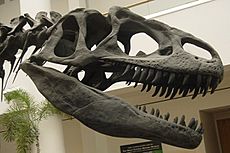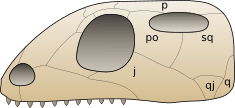Diapsid facts for kids


A diapsid is a type of reptile. It has two special openings, or "holes," on each side of its skull. These holes are located behind the eye. Most reptiles you know are diapsids. However, mammals do not have these holes.
These skull openings have two main jobs. First, they help the jaw muscles move better. Second, they make the skull lighter. The holes also give the jaw muscles a place to attach. When these muscles squeeze, the holes provide space for them to bulge out.
The skull of an Allosaurus is a great example. It shows how dinosaur skulls became lighter. This was especially true for large meat-eating dinosaurs called theropods. Their skulls were like a strong framework of bones. This design made their bite very powerful, even with a lighter skull.
Euryapsids
Some groups of reptiles that lived in water changed over time. They lost the lower of their two skull openings. This left them with only one hole behind each eye. This condition is called "euryapsid." Scientists are quite sure that these animals originally had two holes, like diapsids. They then lost one later on.
Some examples of euryapsids include:
See also
 In Spanish: Diápsidos para niños
In Spanish: Diápsidos para niños



